© 2023 Dr Margaret Sheppard
Training of a Traditional Doctor
The nature of the training is secret but it involves learning how to divine with bones, treat with herbal remedies (both orally and through incisions), and to wash with medicated water. As already noted traditional doctors do not only treat people but also property, Lands, Cattle Posts and livestock. Their treatments not only cure physical and mental symptoms but also protect against the supernatural agents, particularly the actions of Baloi(Witches/sorcerers). They can also heal problems caused by Badimo by appeasing the displeased ancestors. In certain instances they are able to alter the course of future events for example they can bring good luck in gambling etc. Thus during the training all these practices must be learned.
Normally an apprentice will go to live with his teacher (if he does not learn from his father). During his training, the trainee will go with his teacher to all his cases and learn the uses and preparations of all the substances used to make medicines. He will also learn their various administrations. He will learn how to divine with ditaola (bones) and how to prepare his own set, and he will learn the rituals to protect people and property and livestock by washing with medicated water.
But the details of this training is secret. It is said that when traditional doctors are talking to their bones and praising them they are talking to their Badimo who help them, through the bones, to "see". However, as already stated, my informants claimed their power was from God. During their training they are believed to fast at times. Then at the completion of their training a bullock is presented to their teacher by their father. This presentation is on behalf of the paternal kin and Badimo. The trainee's Malome presents a gift on half of the maternal kin and maternal Badimo. The trainer then gives a feast for his trainee to which all his kin are invited. During this feast, according to Setiloane, the teacher and trainee may disappear and they are reputed to spend the time under the water in a r1ver w1th the water snake.
In Kanye I heard of how trainee traditional doctors gathered in the hills amongst the rocks at Cattleposts, singing all night hypnotising the water snake that is believed to live also in caves. It is believed that trained traditional doctors know how to burn certain leaves that make poisonous snakes and animals sleep so that they can remove their saliva, venom, urine or faeces, substances used to make certain strong medicines.
After the feast the new traditional doctor is supposed to remain at his teacher"s house whilst he collects for his ex-
their teacher by their father. Setiloane says this presentation is on
behalf of the paternal kin and Badimo. The trainee's Malome presents
a gift on half of the maternal kin and maternal Badimo. The trainer
then gives a feast for his trainee to which all his kin are invited.
During this feast, according to Setiloane, the teacher and trainee
may disappear and they are reputed to spend the time under the water
. . b d . *1
1n a r1ver e w1th the water snake*1In Kanye I heard of how
trainee traditional doctors gathered in the hills amongst the rocks at
Cattleposts, singing all night hypnotising the water snake that is
believed to live also in caves. It is believed that trained traditional
doctors know how to burn certain leaves that make poisonous snakes and
animals sleep so that they can remove their saliva, venom, urine or
faeces, substances used to make certain strong medicines.
Setiloane continues that after the feast the new traditional
doctor is supposed to remain at his teacher"s house whilst he collects
for his ex-
leave his teacher's house at night and arrive at his own house also
during the night so that he will be found by the herd boys in the
* 1 Water snake -
112
early morning. Heis then taken to a house specially prepared for
him at his home. Until a feast to please the family Badimo is held,
he is attended only by men and old women. The idea of this feast
is to please the Badimo so that they will send him luck in his new
venture.
In March 1982 one of my traditional doctor informants had two
trainees. One was his own son and, very surprisingly, the other one
was a woman. This was despite the fact that I had been previously told
that women are never traditional doctors!
The two trainees spent about a month outside Kanye at their
* 1 . .
teacher's Cattlepost. I was told that they are always trained in
secret outside the village because if the training is done in the
village, Baloi might steal their medicines before they are powerful
enough and hence not only would they themselves be bewitched, but also
all their patients.
~
The lady, although her parents are from Mochudi (Kgatleng
District), had lived all her life in South Africa and is married to a
Mosotho. She told me that from 1962 she had had dreams from her Badimo
telling her that they wanted her to be a traditional doctor. (She
was already a Sangoma). Finally her husband had agreed and so she
had come to train in Kanye after hearing of the great power of my
informant from his patients in Johannesburg. Her Malome was also a
traditional doctor and she had various cousins who were also such.
At the Cattlepost she told me they had studied ditaola
(divination by casting bones), and the use, digging and preparation of
various herbal medicines. They had also learnt the invocations. This
was always done at night. During their training period they had been
subject to various taboos, for example, no sexual intercourse, they
were not allowed to cook, touch pots, fetch water and they had had
their own utensils (i.e. very similar to those to which a Motsetsi is
subject)*2
During the day they would help to diagnose patients with ditaola,
when their trainer threw his bones for a patient they would be called
to make a diagnosis.
When I visited the woman, she had just finished her training
*1 N.B. Both of these trainees were already partly trained. The lady was
already a Sangoma (a South African female diviner) and the man already
knew how to divine with bones, and certain simpler tasks of a
traditional doctor's work.
*2 See Chapter 8.
113
and they had returned to Kanye. She was helping my informant to
prepare his medicines that he would use for washing people. She was
stemping the medicines they had brought from the Cattlepost.
From time to time my informant would add flakes from the inside of a
tortoise shell. After she had stemped them, she sieved them and
emptied them all into the tortoise shell. Then my informant threw
his bones to see if the medicines would be successful in curing
people. When he threw the bones he knocked them on the tortoise shell
and then asked the question as he threw them. Then he invoked his
bones. She repeated each line of an invocation for talking to the
bones. After each invocation she would first attempt to interpret the bones. They were shown by the bones that the medicines would be powerful. This is one of the ways she had learnt to divine and mix herbs.
The lady told me that she would pay her trainer a cow for her instruction.
Training to be a traditional doctor is very difficult and
one of my informants (himself a doctor) told me that many try to train
but fail. They may try for 25 years but still fail. Some may only
be able to learn parts of the training. For example he told me that in his training he had started by learning the treatment of pregnant
women, and the baby in the womb, then studied childbirth, childhood
troubles, then adults up to death and Badimo. He said that some people
only manage to learn the treatments of pregnant women and childbirth.
Others after completing the main training, may go on to study specialist
skills such as the treatment of fractures, madness, menstrual pains, and rain making.*1
Formal Recognition
Today a traditional doctor is st111 controlled by Bathoen II's
Melao ya D1ngaka of 1929. *2 He iS not a owe to pract1se 1n Kanye
unless he has been registered at the Chief's Kgotla. For this
registration he is tested by other traditional doctors. He may also
be registered at the Ministry of Home Affairs in Gaborone. This is
*1 It is difficult to judge how much Rain making still goes on as it
is very secret as it has always been. As the taboos that are
supposed to spoil the rain are still strictly kept, it would be
reasonable to assume that Rain makers still exist.
*2 See Chapter 4 p. 93.
114
controlled by the Traditional Doctors' Association. On registration he
is given a certificate to prove he is registered and licenced to
practice.
Traditional doctors still occupy a very important position.
For example each Kgotla is under a particular traditional doctor who
may also have an assistant, and every new yard in that Kgotla must be
doctored so that it is protected, by that one doctor or his assistant.
This is called go thaya. This doctoring protects its owners and
inhabitants from accidents, thefts, boloi etc. If any household suffers
from these problems the traditional doctor in charge of the Kgotla
will be consulted so that he may heal them. When a person wishes to
build a new yard he takes earth from the site he has been allocated
and the traditional doctor will throw the bones on behalf of that
earth to see if that piece of land is satisfactory for that person.
If it is, he will then go to the site and bury protective medicines
near the future doorway or boundar1es of the house to be built.*1
These protect the whole yard aid its occupants. If he has found that
the site is not all right, then it will be cleansed, or in extreme
cases the owner may even have to build on another site.
All the yards in Kanye, Lands and Cattleposts belonging to one
Kgotla must all be doctored by the same official traditional doctor.
The fee for straightforward doctoring before building a new yard is
5Ot-
to pay as much as a cow for special cleansing.
It is from these fees that a traditional doctor makes his
living. For a straightforward divination, the cost is about 5Ot-
people frequently give an extra lO-
speak". These fees are always laid by the client on the bone bag and
the traditional doctor gathers the money into the bag with the bones.
The fees for protection, cleansing, influencing events etc. are always
'seen in the ditaola”. To cleanse a person who has been bewitched not
to obtain work may be a goat, and to cure alcoholism (there is such a
specialist in Kanye) is P6 or a goat, according to the difficulty of the
case.
In cases of sickness or particular problems such as bringing
luck, patients are free to go to a traditional doctor who is known to
*1 Doorways are always placed according to custom.
See Diagram 1 and 2-
sub-
115
be particularly successful in that field. Many patients come from
all over Botswana and Southern Africa to visit one of my informants.
Another traditional doctor in Kanye is well-
Southern Africa for his skill in thobega (treating fractures).
Doctors consulted like this can command very high fees. Patients,
particularly those from outside Kanye, often come to stay at the
doctor's home whilst they are undergoing treatment.
In March 1982 one of my traditional doctor informants had two trainees. One was his own son and, very surprisingly, the other one was a woman. This was despite the fact that I had been previously told that women are never traditional doctors!
The two trainees spent about a month outside Kanye at their teacher's Cattlepost. I was told that they are always trained in secret outside the village because if the training is done in the village, Baloi might steal their medicines before they are powerful enough and hence not only would they themselves be bewitched, but also all their patients.
The lady, although her parents are from Mochudi (Kgatleng District), had lived all her life in South Africa and is married to a Mosotho. She told me that from 1962 she had had dreams from her Badimo telling her that they wanted her to be a traditional doctor. (She was already a Sangoma). Finally her husband had agreed and so she had come to train in Kanye after hearing of the great power of my informant from his patients in Johannesburg. Her Malome was also a traditional doctor and she had various cousins who were also such.
At the Cattlepost she told me they had studied ditaola (divination by casting bones), and the use, digging and preparation of various herbal medicines. They had also learnt the invocations. This was always done at night. During their training period they had been subject to various taboos, for example, no sexual intercourse, they were not allowed to cook, touch pots, fetch water and they had had their own utensils (i.e. very similar to those to which a Motsetsi is subject.
During the day they would help to diagnose patients with ditaola, when their trainer threw his bones for a patient they would be called to make a diagnosis. Both of these trainees were already partly trained. The lady was already a Sangoma (a South African female diviner) and the man already knew how to divine with bones, and certain simpler tasks of a traditional doctor's work. Therefore this period of their training was much shorter.
:


When I visited the woman, she had just finished her training

When I visited the woman, she had just finished her training and they had returned to Kanye. She was helping my informant to prepare his medicines that he would use for washing people. She was stemping the medicines they had brought from the Cattlepost. From time to time my informant would add flakes from the inside of a tortoise shell. After she had stemped them, she sieved them and emptied them all into the tortoise shell. Then my informant threw his bones to see if the medicines would be successful in curing people. When he threw the bones he knocked them on the tortoise shell and then asked the question as he threw them. Then he invoked his bones. She repeated each line of an invocation for talking to the bones. In all they threw the bones three times. After each invocation she would first attempt to interpret the bones. They were shown by the bones that the medicines would be powerful. This is one of the ways she had learnt to divine and mix herbs.
The lady told me that she would pay her trainer a cow for her instruction.
S

the bones that the medicines would be powerful.
ways she had learnt to divine and mix herbs.
The lady told me that she would pay her trainer a cow for her
After each invocation
They were shown by
This is one of the
instruction.
Training to be a tradi!t>ional doctor is very difficult and
one of my informants (himself a doctor) told me that many try to train


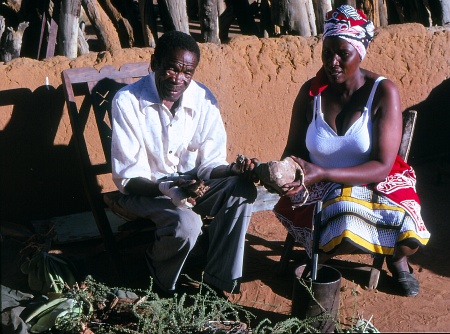




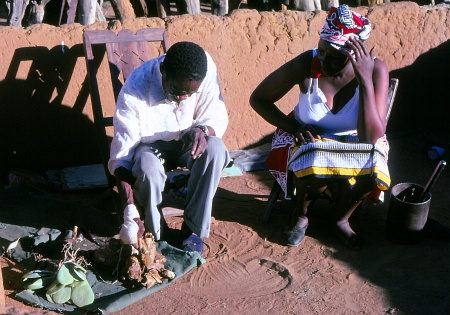
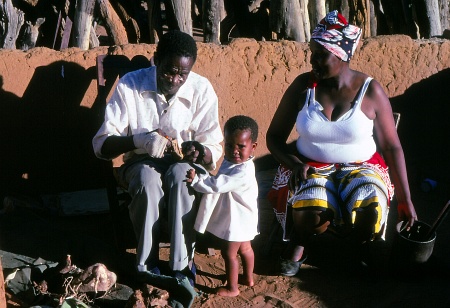






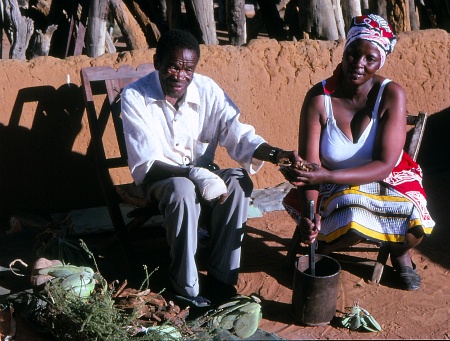
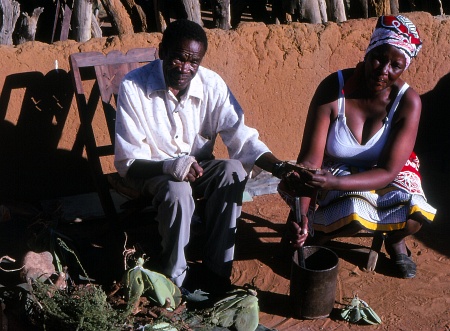


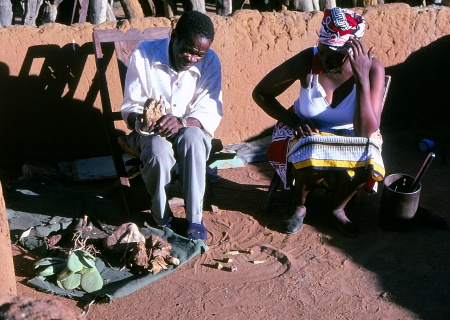

The lady told me that she would pay her trainer a cow for her instruction.
Training to be a traditional doctor is very difficult and one of my informants (himself a doctor) told me that many try to train but fail. They may try for 25 years but still fail. Some may only be able to learn parts of the training. For example he told me that in his training he had started by learning the treatment of pregnant women, and the baby in the womb, then studied childbirth, childhood troubles, then adults up to death and Badimo. He said that some people only manage to learn the treatments of pregnant women and childbirth. Others after completing the main training, may go on to study specialist skills such as the treatment of fractures, madness, menstrual pains, and rain making. It is difficult to judge how much Rain making still goes on as it is very secret as it has always been. As the taboos that are supposed to spoil the rain are still strictly kept, it would be reasonable to assume that Rain makers still exist.
Choosing the traditional herbs to pound into medicines that they collected from the Bush during her training. N.B. a grandson of the traditional doctor is assisting.
These pictures show the tremendous range of healing plants and herbs used by a traditional doctor. (These are just a few examples) The herbs are stemped with a pestle and mortar and then the ex -

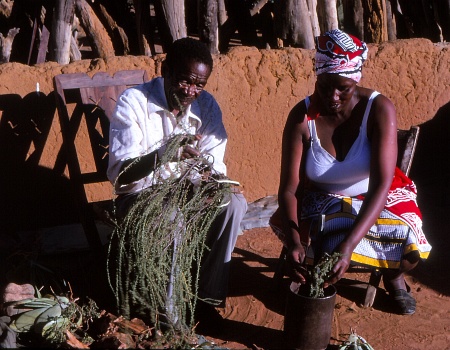
Children living in the household of a traditional doctor become involved from an early age!